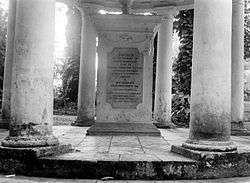Olivia Mariamne Devenish

Olivia Mariamne Devenish (1771 – 26 November 1814), was the spouse of Thomas Stamford Raffles, vice governor of Java (1811–1816), from 1805 to 1814. A memorial monument was erected to her memory in the botanical garden of Buitenzorg (Bogor).
Life
The daughter of George Devenish, Olivia was married in Madras in 1793 to Jacob Cassivelaun Fancourt (d. 1800), and in 1805 in London to Thomas Stamford Raffles. She was born in India but was raised in Ireland. It was commonly said that her second husband, Raffles, was helped in his career through her relationship with his superior. The British author Charlotte Louisa Hawkins Dempster claimed in her memoir The Manners of My Time (1920), that she was Olivia's great-great granddaughter through Captain John Hamilton Dempster, the illegitimate younger half brother of George Dempster of Dunnichen and Skibo, a Director of the East India Company from 1769, and a key figure of the Scottish Enlightenment movement.[1]
While Stamford Raffles was governor on Java, she introduced many social reforms in her capacity as first lady, which set the standard for the rest of the century. She showed herself by the side of her husband at official occasions, such as visits to the native rulers, and held receptions for people of all sexes and ethnicity, which was new on Java, as white women had previously isolated themselves from the native population. At this point, the Western colonists at Java mixed their European habits with East Indian ones: for example, white women born in the East Indies used the Areca catechu, and they only dressed in European fashion on official occasions, such as going to church, receptions and visits, and otherwise wore the more comfortable Asian dress Kebaya and sarong.[2] These habits contributed to what European visitors regarded to be the decadence of the colonial life style in the Dutch East Indies.[3] Devenish banned the use of Areca catechu for western women, and removed to pots for this at the reception rooms from the governor's residence to prevent her guests from using these; she also banned the use of the Asian gown sarong and kebaya for Western women.[4] These informal social reforms were in place for the rest of the 19th-century, and it was not until a century later that Western women in Java again dressed more appropriate according to climate.
She died in Buitenzorg, West Java on 26 November 1814, and was buried in Batavia. Her tomb can still be seen in Taman Prasasti Museum, the former European cemetery of Batavia that had been converted into a museum. In the monument that was erected for her in Buitenzorg it is written:[5]
"Sacred to the memory of Olivia Marianne, wife of Thomas Stamford Raffles, Lieutenant-Governor of Java and its dependencies, who died at Buitenzorg on the 26th November, 1814.
Oh thou Whom Neer My Constant Heart , One Moment Hath Forgot, Tho Fate Severe Hath Bid Us Part, Yet Still Forget Me Not"
References
- ↑ Glendinning, Victoria (2012). Raffles: And the Golden Opportunity, Profile Books, ISBN 1847658245, 9781847658241.
- ↑ Ulbe Bosma & Remco Raben: Being "Dutch" in the Indies: A History of Creolisation and Empire, 1500-1920
- ↑ Ulbe Bosma & Remco Raben: Being "Dutch" in the Indies: A History of Creolisation and Empire, 1500-1920
- ↑ Ulbe Bosma & Remco Raben: Being "Dutch" in the Indies: A History of Creolisation and Empire, 1500-1920
- ↑ Olivia Mariamne Devenish Raffles, findagrave.com